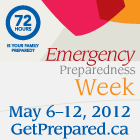Emergency Preparedness Week is May 6 – 12. Here are 6 safety tips and short articles that could help you out in an emergency. For more information on Emergency Preparedness Week visit http://www.getprepared.ca
1. Careful planning; the key to getting through an emergency 72 hours…Is your family prepared?
Canada is a vast country with extreme weather conditions and dramatic geological features. Landslides, flooding, storm surges, earthquakes and other hazards are all potential threats in Canada. But with some careful planning and preparation, Canadians can learn how to deal with these emergencies and minimize the impact to their families and property.
Emergency Preparedness Week 2009 runs from May 3-9. “72 hours…Is your family prepared?” is the theme of this year’s campaign and is designed to encourage Canadians to be prepared to cope on their own for at least the first 72 hours of an emergency, while rescue workers help those in desperate need.
Emergency preparedness is a shared responsibility. While governments at all levels are working hard to keep Canada safe, individual Canadians also have an important role to play in preparing for emergencies. Emergency preparedness experts consistently say that by taking a few simple steps, such as knowing the risks specific to your community , making a plan to help you and your family know what to do, and getting an emergency kit that includes some basic supplies to be self-sufficient for at least 72 hours in an emergency, you are taking a responsible and necessary step to protect yourself and your family from all types of emergencies.
Emergency Preparedness Week is held annually in every part of Canada, together with other levels of government. The campaign is a collaborative effort of federal, provincial and territorial governments. Information and additional tips on Emergency Preparedness Week is available at www.GetPrepared.ca.
2. Family Preparedness: Is your family prepared?
Preparing for an emergency is important and something the whole family can do. By taking a few simple steps, you can become better prepared to face a range of emergencies and minimize the impact on yourselves and your families.
Here are three simple steps to better prepare your family to face a range of emergencies:
- Know the risks – Although the consequences of disasters can be similar, knowing the risks specific to our community and our region (like what to do in the case of floods, tornados, earthquakes, storm surges, hurricanes, and technological or environmental accidents such as chemical spills and power failures) can help us better prepare.
- Make a plan – Every Canadian household needs an emergency plan. It will help you and your family know what to do if disaster strikes. We should all practice what to do in different emergency situations.
- Get an emergency kit – During an emergency, we may need to get by without power or tap water. We will all need some basic supplies (items such as three-day supply of water, non-perishable food, a flashlight, batteries, , battery-operated or wind-up radio, first aid kit, pocket knife, prescriptions, extra set of keys and money, and copies of important documents). Be prepared to be self-sufficient for at least 72 hours in an emergency.
Checklists for what goes into a basic kit and extra items, how to write an emergency plan and details on hazards across Canada can be found on the Emergency Preparedness web site at www.GetPrepared.ca.
3. Community Preparedness: Tips for getting involved
Recent disasters around the world, and here in Canada, have demonstrated the importance of communities becoming prepared for emergencies of all types.
The goal of Emergency Preparedness Week, which runs from May 2-8, is to encourage Canadians to become more engaged in emergency preparedness activities, like the ones listed on www.GetPrepared.ca.
As a member of your community, here are some things you can do to get more involved:
- Talk to your friends, family and co-workers about emergency preparedness. Develop the plans you need to make sure you are ready.
- Volunteer to help your neighbours and co-workers get prepared, and consider volunteering for a local emergency organization.
- Lead efforts in your community. Educate others by teaching them of the importance of emergency preparedness and by encouraging groups to coordinate their efforts.
- Take stock of the emergency response agencies in your community. Ask them what they need and how you can help.
Remember, emergencies can happen anytime, anywhere. Experience has shown that individual preparedness goes a long way towards communities being able to cope better – both during and after a major disaster. More information is available on the Emergency Preparedness at www.GetPrepared.ca.
4. Emergency Management in Canada: How does it work?
In a country that borders on three oceans and spans six time zones, creating an emergency response system that works for every region is essential. Emergency management in Canada is a shared responsibility. That means everyone has an important role to play, including individuals, communities, governments, the private sector and volunteer organizations.
Basic emergency preparedness starts with each individual. If an individual cannot cope, emergency first responders such as police, fire and ambulance services will provide help. If the municipality needs additional assistance or resources, they can call on provincial/territorial emergency management organizations, who can in turn seek assistance from the federal government if the emergency escalates beyond their resource capabilities. Depending on the situation, federal assistance could include policing, national defense and border security, and environmental and health protection.
Requests for assistance from provincial/territorial authorities are managed through Public Safety Canada, which maintains close operational links with the provinces and territories. It can take just a few minutes for the response to move from the local to the national level, ensuring that the right resources and expertise are identified and triggered.
The emergency management system in Canada has many tiers and many players, all of whom have the common goal of preventing or managing disasters. Public Safety Canada is responsible for coordinating emergency response efforts on behalf of the federal government. More information is available on the Public Safety web site at www.publicsafety.gc.ca.
5. How to survive a major earthquake
Canada has approximately 3,500 earthquakes every year. Are you prepared if one were to happen in your area? Here’s how:
Before:
- Get an emergency survival kit.
- Identify safe spots in each room in your home. Emphasize their location by having everyone in the household physically place themselves in the safe spot.
- Move or secure objects that could fall and injure you such as books, plants, mirrors, lamps or china. Keep heavy items on lower shelves. Affix paintings and other hanging objects securely so they won’t fall off hooks.
During:
- Stay inside.
- Take cover under a heavy table, desk or any solid furniture and hold on.
- If you can’t get under something strong, or if you are in a hallway, flatten yourself or crouch against an interior wall.
- Stay away from windows, glass partitions, mirrors, fireplaces, bookcases, tall furniture and light fixtures. In an earthquake you could be hurt by shattered glass or heavy objects thrown around by the shaking.
For more tips, go to www.GetPrepared.ca.
6. Floods – what to do
Floods can have significant effect on people and property. Do you know what to do before and after a flood? Here are some basic tips:
Before:
- Get an emergency kit.
- Put weather protection sealant around basement windows and the base of ground-level doors.
- Install the drainage for downspouts a sufficient distance from your residence to ensure that water moves away from the building.
- Consider installing a sump pump and zero reverse flow valves in basement floor drains.
After:
- For health reasons, it’s important to restore your home to good order as soon as possible but make sure the property is safe to re-enter before.
- To avoid electrical shock wear rubber boots, keep extension cords out of the water and shut the power off to the flooded area at the breaker box.
- Remove standing water with pumps or pails, then with a wet/dry shop vacuum.
- Remove all soaked and dirty materials and debris, including wet insulation and drywall, residual mud and soil, furniture, appliances, clothing and bedding.
For more information on how to get prepared for an emergency, go to www.GetPrepared.ca.
You may also want to check out Environment Canada’s website at www.weatheroffice.gc.ca for more tips, or to learn more about Weatheradio Canada. This service offers weather and related information 24 hours a day, in both official languages. A weatheradio receiver can also be set up to automatically start broadcasting when Environment Canada issues a severe weather warning. The nationwide network has 180 sites across the country and reaches 92% of the Canadian population.





